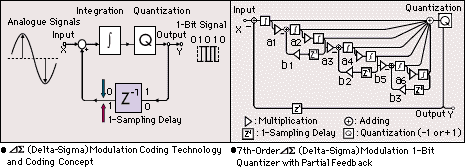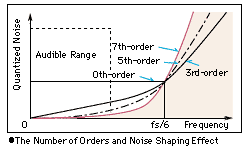|
|
|
|
 |
|
|
|
High-Speed Sampling 1-Bit Coding Process
|
|
|
|
The dominant method for coding analogue signals into digital is PCM (Pulse Code Modulation). PCM samples the original analogue signal at a frequency more than double the bandwidth being transmitted, quantizes and then converts the sample into multi-bit encoded signals. In this system the sampling frequency (fs) determines the transmission bandwidth (fs/2) and the number of bits for quantization determines the dynamic range.
|
|
|
 |
|
|
|
When CD was developed, PCM with its 16-bit quantization for recording and 44.1 kHz sampling frequency was the most technological method for digitizing analogue samples. While PCM was a remarkable technological advancement in recording, the playback frequency range and dynamic range it produced were limited. PCM can not record all the sounds which exist in nature. However, thanks to advances in digital technologies, there is now another coding technology which attains ample dynamic range in the audible range by increasing the sampling frequency and shifting quantization noise to the high frequency spectrum. This is attained even though the number of bits for quantization used is small.
 This approach is based on a noise shaping technology that uses a delta-sigma modulation to control the distribution of quantization noise. Binary signals quantized by this technology are transformed into 1-bit signals. Known as " A/D" and "1-bit A/D", this technology has found practical applications in a number of analogue-to-digital conversion devices. The 1-bit signal has a sampling frequency of 64 fs (fs = 44.1 kHz, 2.8224 MHz), and can guarantee a theoretical dynamic range of 120 dB (0 Hz to 20 kHz) and a frequency response of 0 Hz to 100 kHz by 7th-order delta-sigma modulation. This approach is based on a noise shaping technology that uses a delta-sigma modulation to control the distribution of quantization noise. Binary signals quantized by this technology are transformed into 1-bit signals. Known as " A/D" and "1-bit A/D", this technology has found practical applications in a number of analogue-to-digital conversion devices. The 1-bit signal has a sampling frequency of 64 fs (fs = 44.1 kHz, 2.8224 MHz), and can guarantee a theoretical dynamic range of 120 dB (0 Hz to 20 kHz) and a frequency response of 0 Hz to 100 kHz by 7th-order delta-sigma modulation. |
|
|
|
|
|
|